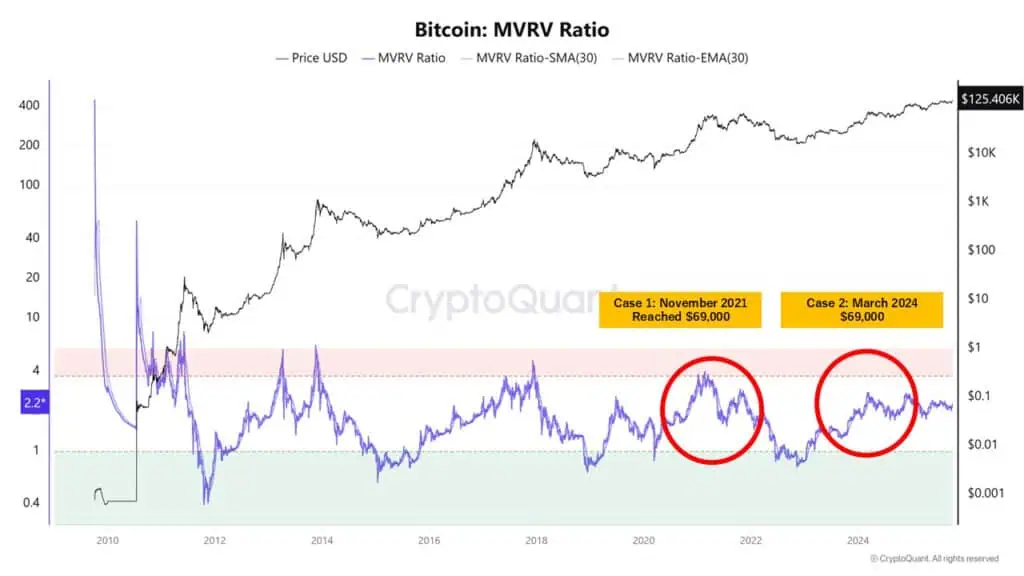
Bitcoin hit a new all-time high of $126.080 on October 6. What do key indicators say about what might come next?
On October 6, the price of Bitcoin reached for the first time in its history the $126.080, a milestone that put cryptocurrency back at the center of the global financial conversation. The all-time high not only reflects renewed investor appetite, but also opens the door to an inevitable question: What typically happens after Bitcoin hits a new all-time high?
Experience from previous cycles shows that the market tends to react with a mix of euphoria and caution. Volatility is intensifying, short-term traders are taking advantage of the situation to take profits, and at the same time, analysts are closely monitoring two chain indicators that usually predict the direction: the Bitcoin reserves on exchanges and MVRV ratio, which measures the difference between market value and the average acquisition cost of the holders.
Trade BTC here and take advantage of the consolidation after the ATHExchange reserves and the pulse of Bitcoin supply
CryptoQuant analysts recently published a report, indicating that Bitcoin reserves on exchanges have historically been a selling pressure thermometerWhen investors withdraw their coins to cold wallets, the available supply of BTC on the market decreases, which is often interpreted as a sign of long-term accumulation and confidence. Conversely, when reserves increase, it's understood that traders are preparing liquidity to sell, which increases the risk of corrections.
The clearest example occurred after the November 2021 high, when Bitcoin reached $69.000. At that point, reserves began to rise after months of declines, coinciding with an overheated MVRV and a market sentiment that shifted from euphoria to fear in a matter of weeks. The result was a prolonged bear market that extended through much of 2022 and 2023.
The situation was different in March 2024, when Bitcoin again surpassed $69.000. On that occasion, reserves remained low and trading volumes increased, allowing rapid declines to be absorbed by the inflow of institutional capital through Bitcoin spot ETFs and the narrative of the halving, which halves the mining reward. This pattern of flat reserves and moderate MVRV was interpreted as a sign of structural strength, and indeed the BTC price continued to climb in the following months.

Source: CoinGecko
Now, following the new record of $126.080, analysts are looking at these metrics again. According to data from Glassnode and CryptoQuant, Exchange reserves remain at historically low levels, suggesting that large holders continue to invest in accumulation. This dynamic reduces immediate selling pressure and leaves open the possibility that the market will continue to explore higher prices.
Manage your Bitcoin with Bit2Me with total securityThe role of MVRV and the rotation into altcoins
The second key indicator is the MVRV ratio, which measures how much the market value is above investors' average purchase price. When this metric spikes, it means a large portion of the market is accumulating unrealized profits, which often incentivizes sell-offs. In 2021, the MVRV reached extreme levels, coinciding with the whales' coin distribution and the start of the correction.
In the 2024-2025 cycle, the trend has been more moderate. The MVRV has risen, but without reaching the overheating levels of 2021. This has allowed corrections to be shorter and the market to maintain a bullish structure of increasingly higher highs. For analysts, this pattern is consistent with a market that still has room to grow, although it is not exempt from episodes of intense volatility.

Another recurring phenomenon following an all-time high is the rotation of capital into other cryptocurrencies. In March 2024, when Bitcoin stabilized after surpassing $69.000, part of the flow shifted to Ethereum and other large-cap altcoins. This movement is often accompanied by an increase in whale activity, which diversifies positions and seeks to capture profits in assets with greater relative growth potential.
Currently, early signs point to a similar trend. Ethereum has seen a surge in volume and price in the days following Bitcoin's new record, while projects linked to asset tokenization and scalability infrastructure are also showing renewed interest.
Buy BTC on Bit2Me and don't miss out on the next rally.What will happen to the price of Bitcoin now that it has reached a new ATH?
The history of Bitcoin shows that every all-time high is accompanied by a period of adjustment, where volatility and profit-taking are inevitableAt the time of writing, the price of Bitcoin is hovering around $121.000, due to these factors.
However, current indicators paint a different picture than in 2021. Exchange reserves remain low and MVRV remains at moderate levels., which suggests that the market is not in a phase of massive distribution, but rather in a consolidation process with room for further increases.
Still, this doesn't mean the road ahead is free of setbacks. The coming months will likely bring rapid corrections and record-breaking sell-offs, but the overall structure points to a more mature market, supported by the influx of institutional capital and long-term narratives such as the adoption of Bitcoin as a digital reserve asset.
In short, the ATH of $126.080 The price reached in October 2025 doesn't necessarily mark a definitive ceiling. Rather, according to data from Glassnode and CryptoQuant, it could be another step in Bitcoin's price discovery process in 2025, where the key will be to closely monitor exchange reserves and the evolution of the MVRV to anticipate whether the market is heading towards a new bullish phase or a possible deeper correction.
Buy BTC today: every ATH opens new opportunities

